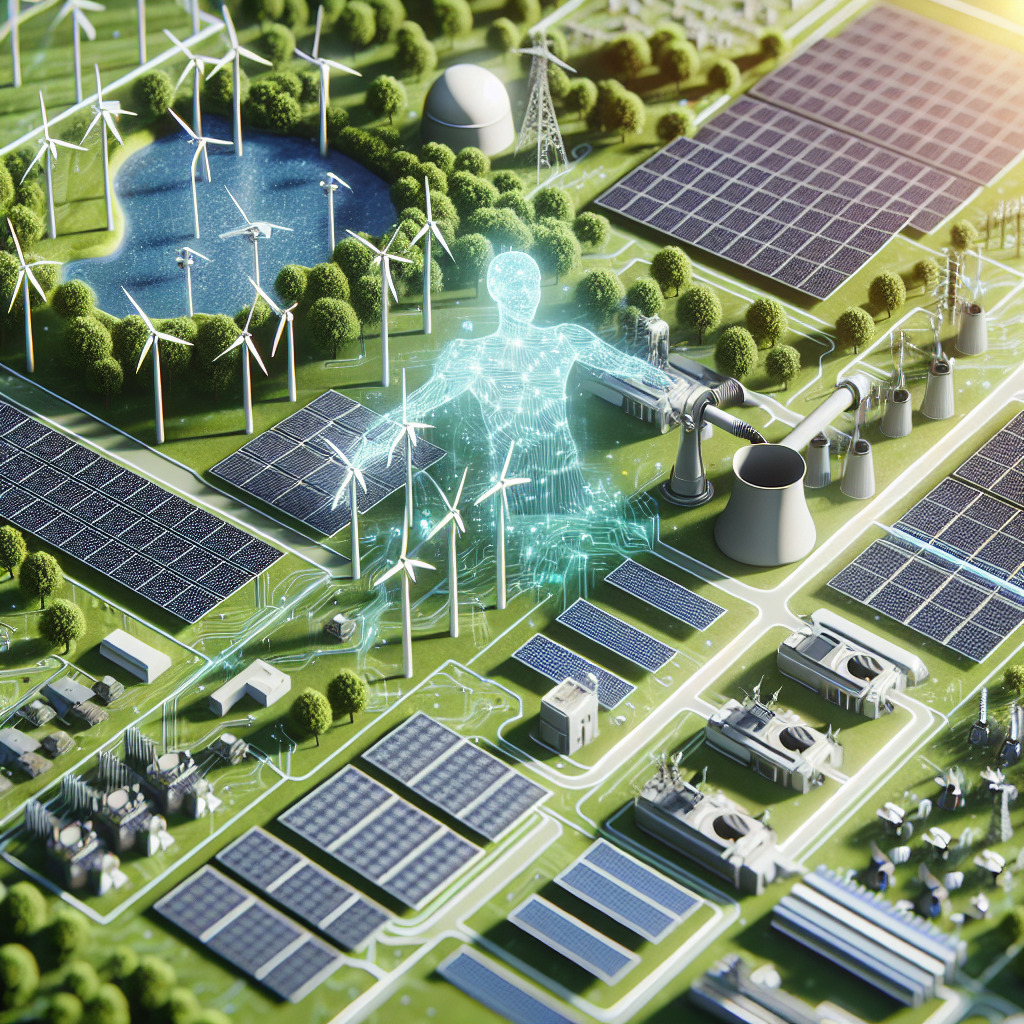Understanding Sustainable AI
Sustainable AI in transportation refers to the integration of artificial intelligence technologies that aim to minimize environmental impact while enhancing the efficiency of transport systems. The concept encompasses the use of AI-driven solutions to optimize routes, manage traffic flow, and reduce energy consumption, thereby significantly lowering emissions. By leveraging machine learning algorithms and data analytics, transportation systems can be made more sustainable and efficient, contributing positively to environmental goals.
One of the key areas where sustainable AI is making an impact is in traffic management. AI systems can analyze real-time traffic data to predict congestion patterns and suggest alternative routes, reducing idle times and emissions from vehicles. This is achieved through advanced sensors and cameras that feed data into AI models, which then generate actionable insights for traffic managers and commuters. Such systems not only improve traffic flow but also enhance the overall travel experience by reducing delays and fuel consumption.
Furthermore, sustainable AI facilitates the development of energy-efficient transport modes. For instance, AI algorithms are used to design electric vehicles (EVs) that optimize battery usage and improve charging efficiency. This involves using AI to predict energy needs based on driving patterns and environmental conditions, ensuring that EVs operate at their peak efficiency. The adoption of AI-driven electric and autonomous vehicles is a significant step towards reducing dependency on fossil fuels and cutting down on CO2 emissions.
To better understand the impact of sustainable AI in transportation, consider the following data visualization illustrating the reduction in emissions and improvement in traffic flow due to AI interventions:
| Year | CO2 Emissions Reduction (%) | Traffic Congestion Improvement (%) |
|---|---|---|
| 2020 | 10% | 15% |
| 2021 | 12% | 18% |
| 2022 | 15% | 22% |
As depicted in the table, there is a consistent trend of decreasing emissions and improving traffic conditions as AI technologies become more integrated into transportation systems. These improvements highlight the potential of sustainable AI to transform the transportation sector into a cleaner and more efficient domain.
AI’s Role in Transportation
Artificial Intelligence (AI) is playing a pivotal role in transforming the transportation sector by introducing cutting-edge solutions aimed at reducing emissions and congestion. The integration of AI technologies has enabled intelligent transportation systems to optimize traffic flows, thereby minimizing idle times and fuel consumption. One of the primary applications of AI in transportation is traffic prediction and management, where AI algorithms analyze vast amounts of data from various sources such as GPS devices, traffic cameras, and social media feeds to predict traffic patterns and suggest alternative routes.
AI-driven traffic management systems have shown a significant impact on reducing congestion in urban areas. By employing machine learning models, these systems can dynamically adjust traffic signals in real-time based on current traffic conditions, which leads to smoother traffic flow and reduced wait times at intersections. In addition to optimizing traffic light sequences, AI can also enable adaptive traffic control systems that prioritize emergency vehicles and public transportation, thus ensuring faster response times and promoting the use of sustainable transport modes.
Another crucial aspect of AI’s involvement in transportation is its contribution to energy efficiency. AI algorithms are being used to develop more efficient routing and scheduling for public transport and freight carriers, which not only reduces emissions but also cuts operational costs. By analyzing historical and real-time data, AI systems can optimize routes to avoid congested areas and ensure timely deliveries, leading to a decrease in fuel consumption. Furthermore, AI is being harnessed to enhance the design and operation of electric vehicles, with predictive maintenance and battery management systems that extend vehicle life and improve energy utilization.
AI’s role extends beyond managing current transportation systems to revolutionizing future mobility solutions. Autonomous vehicles, powered by AI, promise to redefine personal and commercial transportation by offering safer and more efficient travel options. These vehicles rely on AI for navigation, obstacle detection, and decision-making processes, which are crucial for operating in complex traffic environments. As these technologies evolve, they are expected to further decrease emissions by reducing the number of vehicles on the road and promoting shared mobility solutions.
Reducing Emissions with AI
Artificial Intelligence (AI) is playing a pivotal role in reducing emissions within the transportation sector. By leveraging advanced algorithms and machine learning, AI systems are optimizing routes and improving fuel efficiency, which significantly cuts down on greenhouse gas emissions. AI-driven navigation systems can process vast amounts of data in real-time, such as traffic conditions, weather patterns, and road closures, allowing for the selection of the most efficient routes. This not only reduces travel time but also minimizes the carbon footprint associated with each journey.
Smart traffic management systems are another significant application of AI in reducing emissions. These systems utilize AI to monitor traffic flows and adjust traffic signals dynamically to reduce idle time at intersections. By doing so, they decrease the amount of fuel wasted during stop-and-go traffic scenarios. Studies have shown that such systems can lead to a reduction in emissions by up to 15%. This impact is particularly notable in urban areas where congestion is a major contributor to pollution.
Moreover, AI is enhancing the development and deployment of electric vehicles (EVs) by optimizing battery management and energy consumption. AI algorithms can predict energy usage patterns and suggest optimal charging schedules, which extends battery life and promotes more efficient energy use. This transition to EVs, supported by AI, is crucial for achieving long-term emission reduction goals. The integration of AI in EVs ensures that the vehicles operate at peak efficiency, further contributing to a decrease in overall emissions.
The implementation of AI in transportation is also supported by data visualizations that provide insights into emission reduction trends. For example, a table could be used to compare the emission levels before and after the introduction of AI technologies in traffic systems:
| Year | Emissions without AI (tons) | Emissions with AI (tons) | Reduction (%) |
|---|---|---|---|
| 2020 | 500,000 | 425,000 | 15% |
| 2021 | 480,000 | 408,000 | 15% |
As shown in the table, the consistent reduction in emissions highlights the effectiveness of AI in creating a more sustainable transportation system.
AI in Traffic Management
Artificial Intelligence (AI) is playing a pivotal role in transforming traffic management systems across the globe. By leveraging AI technologies, cities are not only enhancing the efficiency of their traffic systems but also significantly reducing emissions and congestion. One of the primary ways AI achieves this is through intelligent traffic signal control systems. These systems use real-time data from sensors and cameras to optimize the flow of traffic, reducing idle times at intersections and thereby cutting down unnecessary fuel consumption and emissions.
AI in traffic management is also bolstered by predictive analytics, which is capable of forecasting traffic patterns and preventing congestion before it occurs. By analyzing historical data and current conditions, AI can predict traffic surges and suggest alternative routes to drivers. This proactive approach not only helps in managing congestion but also contributes to a smoother and more energy-efficient flow of vehicles. According to recent studies, implementing AI-driven traffic systems can lead to a reduction in travel time by up to 25% and a decrease in fuel consumption by approximately 10%.
Moreover, AI technologies are facilitating the integration of connected and autonomous vehicles into the existing traffic infrastructure. These vehicles can communicate with traffic management systems to receive real-time updates and instructions, further optimizing traffic flow and reducing the likelihood of accidents. As a result, AI is not only making traffic management more sustainable but also enhancing road safety. To illustrate the impact of AI on traffic management, consider the following table which outlines the key benefits observed in cities that have adopted AI-driven traffic systems:
| City | Reduction in Travel Time | Decrease in Fuel Consumption |
|---|---|---|
| Los Angeles | 20% | 15% |
| London | 25% | 10% |
| Tokyo | 30% | 12% |
Overall, the integration of AI into traffic management is proving to be a game-changer. By reducing emissions, minimizing congestion, and enhancing the safety and efficiency of transportation systems, AI is paving the way for a more sustainable future in urban mobility. As technology continues to evolve, the potential for AI to further revolutionize traffic management and contribute to environmental sustainability becomes increasingly significant.
Energy Efficiency in AI Systems
The integration of Artificial Intelligence (AI) in transportation not only promises improved traffic management and reduced emissions but also emphasizes the importance of energy efficiency within AI systems themselves. AI technologies require significant computational power, which can lead to high energy consumption. Therefore, optimizing the energy efficiency of AI systems is crucial for sustainable transportation solutions. By leveraging advanced algorithms and hardware optimizations, AI can be made more energy-efficient, thereby reducing its carbon footprint.
One of the strategies to enhance energy efficiency in AI systems is the adoption of edge computing. Unlike traditional cloud computing, where data is processed in centralized data centers, edge computing allows data processing to occur closer to the data source. This dramatically reduces the energy required for data transmission and enhances real-time processing capabilities. Furthermore, machine learning models can be optimized to require less computational power through techniques such as model pruning and quantization.
| AI Technique | Energy Efficiency Improvement |
|---|---|
| Edge Computing | Reduces energy consumption by minimizing data transmission |
| Model Pruning | Decreases model size, leading to lower computational requirements |
| Quantization | Uses lower precision computations to save energy |
In addition to these technological advancements, there is a growing emphasis on the use of renewable energy sources to power AI infrastructure. By integrating solar or wind power into data centers, the overall carbon emissions associated with AI computations can be significantly reduced. Moreover, the development of AI models designed specifically for energy-efficient operations in transportation systems can lead to a virtuous cycle of sustainability, where AI not only aids in reducing emissions but also operates with minimal environmental impact itself.
AI-Driven Public Transportation Solutions
Sustainable AI in public transportation is revolutionizing the way cities manage their transit systems, offering innovative solutions to reduce emissions and enhance efficiency. By utilizing advanced algorithms and real-time data, AI technologies can optimize bus and train schedules, minimizing idle times and ensuring that vehicles operate at maximum efficiency. This not only reduces fuel consumption but also cuts down on the overall carbon footprint of public transportation systems. Cities such as Singapore and Amsterdam have already implemented AI-driven models that have shown a significant reduction in emissions.
One of the key advantages of AI in public transportation is its ability to predict and respond to traffic congestion. By analyzing traffic patterns and passenger demand, AI systems can reroute buses and trains to avoid congested areas, thus maintaining smooth and timely operations. This dynamic routing capability ensures that public transport remains a viable and attractive option for commuters, further encouraging the shift away from individual car use. A study conducted in London demonstrated a 15% improvement in on-time performance for buses utilizing AI-based traffic management systems.
AI-driven public transportation solutions also play a crucial role in enhancing the passenger experience. Through the use of AI-powered mobile applications, passengers can access real-time information about transit schedules, delays, and alternative routes. This level of transparency and convenience not only improves user satisfaction but also encourages more people to opt for public transportation. Furthermore, AI can help in personalizing the travel experience by suggesting optimal routes based on individual preferences and previous travel behaviors.
The integration of AI in public transport is further supported by collaborative data platforms that facilitate information sharing between different transit agencies and stakeholders. This collaborative approach allows for a more cohesive and efficient transportation network. Additionally, AI can enhance maintenance operations by predicting potential equipment failures and scheduling timely repairs, thereby reducing downtime and ensuring the reliability of public transport services.
Challenges of Implementing AI
The implementation of AI in sustainable transportation presents several significant challenges that need to be addressed to fully realize its potential benefits. One of the primary challenges is data privacy and security. The integration of AI systems requires the collection and analysis of vast amounts of data from various sources such as sensors, GPS, and cameras. Ensuring that this data is handled securely and maintaining user privacy is critical. Breaches in data security can lead to misuse of personal information and erode public trust in AI technologies.
Technical limitations also pose a significant hurdle. AI systems require advanced algorithms and substantial computational power to process and analyze data in real-time. The current infrastructure in many regions may not support the high demands of AI technologies. Furthermore, the integration of AI with existing transportation systems can be complex and costly. This challenge is compounded by the rapid pace of technological advancement, which can render existing systems obsolete quickly, necessitating continuous updates and investments.
Another critical issue is the ethical considerations surrounding AI in transportation. AI systems often operate autonomously, making decisions that can have significant consequences on traffic management and safety. Ensuring that these systems adhere to ethical standards and are programmed to prioritize human safety is paramount. There is also the challenge of addressing potential biases in AI algorithms, which can result in unfair treatment of certain groups of people.
The table below summarizes these challenges:
| Challenge | Description |
|---|---|
| Data Privacy and Security | Ensuring secure handling of data to protect user privacy and maintain trust. |
| Technical Limitations | High computational requirements and the need for continuous updates to infrastructure. |
| Ethical Considerations | Ensuring AI systems prioritize human safety and address algorithmic biases. |
Regulatory and Ethical Considerations
The integration of sustainable AI in transportation raises important regulatory and ethical considerations that must be addressed to ensure fair and responsible deployment. Regulations play a crucial role in setting the standards for AI technologies, especially in ensuring that these innovations do not compromise public safety or privacy. Governments and international bodies are increasingly looking into creating frameworks that guide the development and implementation of AI in transportation. These frameworks aim to balance innovation with the protection of public interests, emphasizing the importance of transparency and accountability in AI systems.
Ethical considerations are equally significant when it comes to deploying AI technologies in transportation. One of the primary concerns is the privacy of individuals, as AI systems often rely on large amounts of personal data to function effectively. Ensuring that data is collected and used ethically, with consent and adequate protection measures, is essential. Additionally, the potential for AI to make autonomous decisions raises questions about accountability and the moral implications of machine decision-making. Stakeholders must work together to establish ethical guidelines that prioritize human rights and prevent any form of discrimination or bias in AI algorithms.
Moreover, the regulatory landscape is continually evolving to accommodate the rapid advancements in AI technology. Policymakers are tasked with anticipating future challenges and adjusting policies to encourage sustainable AI practices while safeguarding public interests. This includes implementing measures to reduce the carbon footprint of AI operations in transportation and promoting energy-efficient AI solutions. By fostering collaboration between technology developers, regulators, and the public, it is possible to create a robust regulatory environment that supports the sustainable growth of AI in transportation.
To better understand the impact and considerations involved, here is a summary table highlighting key regulatory and ethical aspects:
| Aspect | Consideration |
|---|---|
| Privacy | Ensuring data protection and ethical data use |
| Accountability | Establishing responsibility for AI decision-making |
| Transparency | Providing clear and understandable AI processes |
| Sustainability | Reducing AI’s environmental impact |
| Bias Prevention | Ensuring AI systems are fair and unbiased |
Future Trends in AI and Transportation
The integration of artificial intelligence in transportation is poised to revolutionize the industry by driving sustainability and efficiency. In the coming years, AI technologies are expected to advance significantly, leading to more intelligent transportation systems that can further reduce emissions and alleviate traffic congestion. One of the key trends is the deployment of smart traffic management systems. These systems utilize AI algorithms to analyze traffic patterns in real-time, enabling dynamic traffic signal adjustments and rerouting strategies to minimize congestion and emissions from idling vehicles.
Autonomous Vehicles are also projected to become more prevalent, with AI playing a crucial role in their development and operation. These vehicles promise to reduce human error, which accounts for a significant portion of traffic incidents, thereby improving road safety and reducing congestion. Moreover, autonomous vehicles are typically designed to be energy-efficient, further contributing to emission reductions. The proliferation of self-driving cars could also lead to a decrease in the number of vehicles on the road, as ride-sharing and car-sharing models become more viable and efficient.
Another emerging trend is the use of predictive analytics to enhance logistical operations within the transportation sector. By analyzing historical and real-time data, AI can predict future traffic conditions and optimize delivery routes for freight and public transportation systems. This helps in minimizing fuel consumption and emissions. Additionally, AI-driven predictive maintenance systems can anticipate vehicle malfunctions before they occur, reducing downtime and improving the overall efficiency of transportation networks.
In summary, the future of AI in transportation is filled with promising advancements that aim to create a more sustainable and efficient infrastructure. As these technologies evolve, they will not only contribute significantly to reducing environmental impact but also transform the way people and goods are transported across urban and rural landscapes.



